If your home is equipped with a sump pump, there usually is a good reason for it. The purpose of a sump pump is to collect water from around your foundation and redirect it away from your foundation. If it fails, you could end up with thousands of dollars of damage, potential foundation failures, and even mold problems if your basement floods.
There is another type of pump that you may find in your basement called a sewage lift pump. This is a sealed system that is used if the soil stack to the municipal sewer system or your septic system is higher than the floor of your basement. We will not be discussing this type of sump pump for the purpose of this article.
It Begins at the Foundation
The adjacent picture shows a foundation under construction. 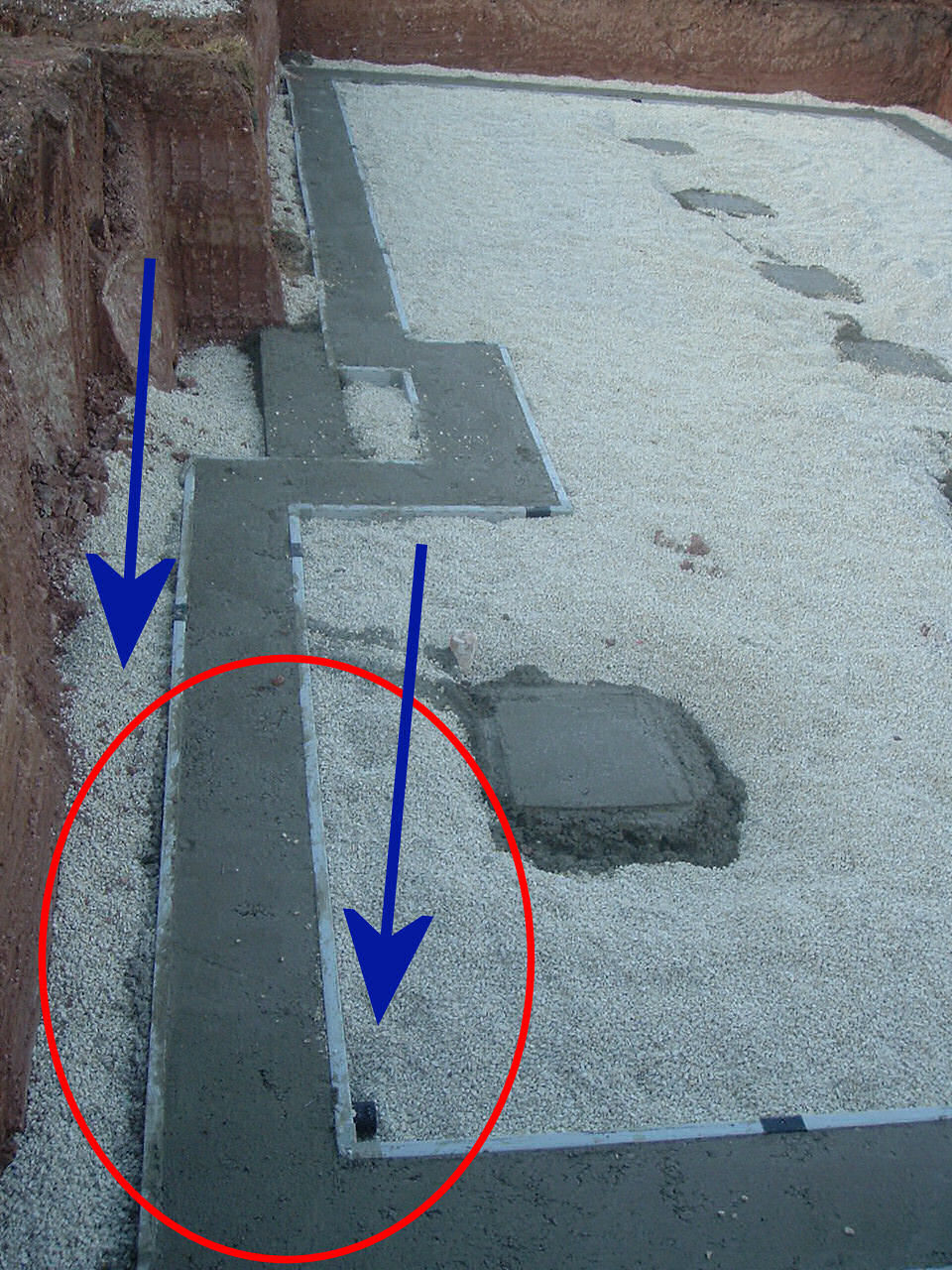 There is drain pipe installed under the gravel around the entire perimeter of the home. The blue arrows show the drainage system location. If you look closely in the red circle,you can see the drain pipe that enters the basement.
There is drain pipe installed under the gravel around the entire perimeter of the home. The blue arrows show the drainage system location. If you look closely in the red circle,you can see the drain pipe that enters the basement.
This drain pipe will be visible inside the sump crock when the basement is finished.
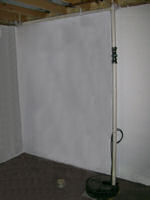 Finished Installation
Finished Installation
This is a typical finished installation of the sump pump. In this picture you will see the covered sump crock, the discharge pipe, and the check valve. The pump is plugged into a dedicated receptacle located near the crock. This is very important. You should not use this receptacle for any other use except for a battery back-up system! If you do, you could risk overloading the circuit causing the breaker to trip. If there is no power supplied to your pump, it would quit working. If you need additional circuits, hire an electrician to install them for you. Remember, your sump pump helps protect your from basement flooding!
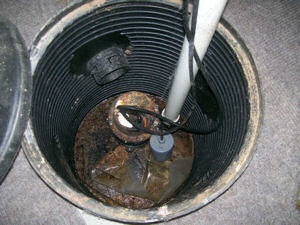 Type of Pumps
Type of Pumps
You may find one of these two styles of pumps in your home. The first one is a submersible. The entire pump and motor fits under the cover. The pump is activated when the crock fills with water and the float rises. Inside the float,there is a switch that completes the circuit when it is in the vertical position. The pump will continue to run until the crock drains down and the float falls to the side. Make sure the float can move freely. If it would get stuck, your pump will not turn on or off like it should.
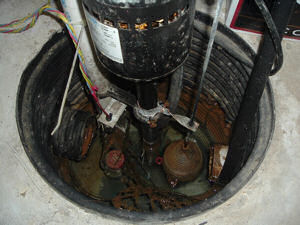 The second type of pump is called a pedestal. This pump also has a float that looks similar to the one in a toilet. It's attached to a rod that sticks up through the cover of the crock and is attached to a motor above. The pump is located at the bottom of the crock. Occasionally, the cover will get bumped and may jam the rod. If this happens, the rod will not be free to move up and down to turn the pump on and off. If you have this style of pump, you should be able to move the rod up and down freely to turn the motor on and off.
The second type of pump is called a pedestal. This pump also has a float that looks similar to the one in a toilet. It's attached to a rod that sticks up through the cover of the crock and is attached to a motor above. The pump is located at the bottom of the crock. Occasionally, the cover will get bumped and may jam the rod. If this happens, the rod will not be free to move up and down to turn the pump on and off. If you have this style of pump, you should be able to move the rod up and down freely to turn the motor on and off.
There is a downfall to be aware of with this style of a pump. During periods when the pump is very active, the pump's motor can get very hot. Even to the point when it may fail to work. The submersible pump is naturally cooled by the water that surrounds it in the crock. If your pump is very active, it is wise to always have a spare pump on hand. Murphy's law says the pump will fail at 2 am when your favorite plumbing supply or big box store is closed!
Battery Back-Up Systems
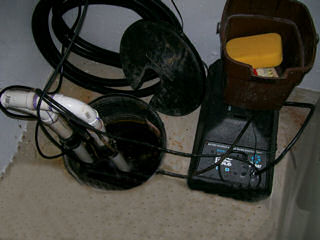 Starting around $250 a battery back-up pump is a good idea to install in tandem with your current sump pump. This pump is installed above the existing pump and is connected to a 12 volt marine type battery that is charged by your home's electrical system. In the event you lose power, the battery back-up will take over and pump the water out of the crock. When this happens, an alarm sounds to alert you the pump was activated due to a power outage. This is a good idea to have if you have a finished basement and want protection in case of a power failure. This works well if you loose power for a few hours. If the power is out for longer periods of time, there are more expensive units available starting at $800
Starting around $250 a battery back-up pump is a good idea to install in tandem with your current sump pump. This pump is installed above the existing pump and is connected to a 12 volt marine type battery that is charged by your home's electrical system. In the event you lose power, the battery back-up will take over and pump the water out of the crock. When this happens, an alarm sounds to alert you the pump was activated due to a power outage. This is a good idea to have if you have a finished basement and want protection in case of a power failure. This works well if you loose power for a few hours. If the power is out for longer periods of time, there are more expensive units available starting at $800
Check Valves
Check valves are usually installed in your discharge line to prevent water from flowing into your crock from the outside of the home. It also helps to take some of the load off your pump depending how far the discharge point is from the sump pump.
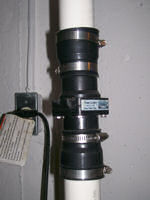 Most sump crocks are 24 inches in diameter. That means every inch if water in the crock equals about 2 gallons of water. Most sump crocks have a working range of about 20 gallons (10 inches). Without a check valve and the discharge point leading outside your home was 20 feet from the pump, measured horizontally along the pipe, your pump would discharge 20 gallons of water and get 2 gallons of water back. That's losing 10% efficiency!
Most sump crocks are 24 inches in diameter. That means every inch if water in the crock equals about 2 gallons of water. Most sump crocks have a working range of about 20 gallons (10 inches). Without a check valve and the discharge point leading outside your home was 20 feet from the pump, measured horizontally along the pipe, your pump would discharge 20 gallons of water and get 2 gallons of water back. That's losing 10% efficiency!
Look Outside!
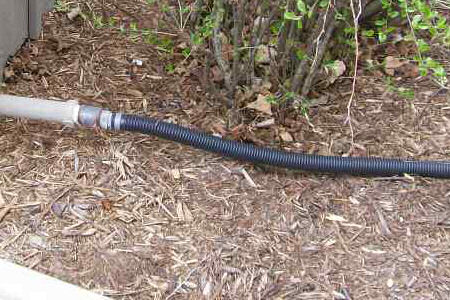 It is important to keep the discharge point of your sump pump as far from your foundation as possible. The minimum distance should be 10 feet. Most discharge pipes have a flexible hose tightly attached to the pipe coming from the basement. During non-freezing weather this works just fine.
It is important to keep the discharge point of your sump pump as far from your foundation as possible. The minimum distance should be 10 feet. Most discharge pipes have a flexible hose tightly attached to the pipe coming from the basement. During non-freezing weather this works just fine.
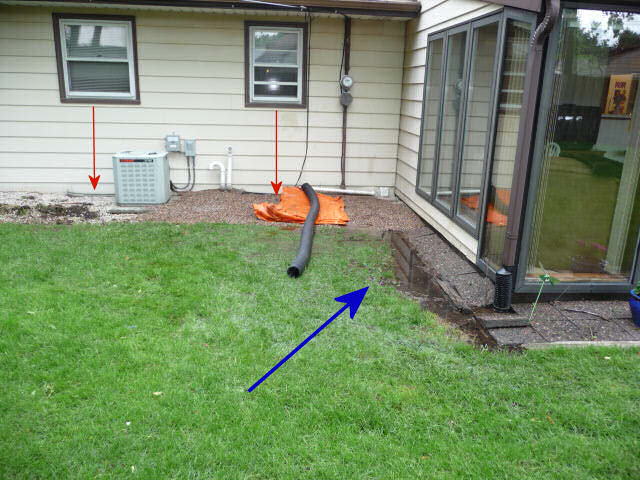 Here's a situation at a home we inspected after heavy rains. There are several problems. The discharge hose was not tightly connected to the PVC pipe exiting the home and was leaking. The home owner put down a tarp but did little good. There also was a low spot near the foundation and the water had no where to go except...
Here's a situation at a home we inspected after heavy rains. There are several problems. The discharge hose was not tightly connected to the PVC pipe exiting the home and was leaking. The home owner put down a tarp but did little good. There also was a low spot near the foundation and the water had no where to go except...
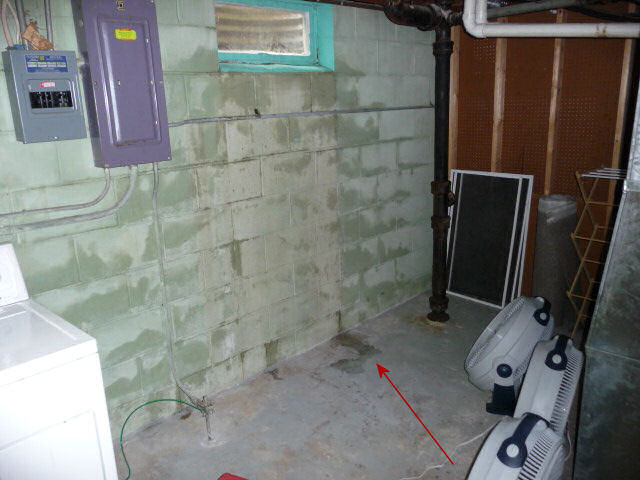 ...right back into the basement. Very small corrections can make a big difference. Make sure to take a walk around your home during a heavy rain. If you see pooling near the foundation, corrections are necessary. A good rule of thumb is a slope of at least 6 inches over 10 feet away from your home.
...right back into the basement. Very small corrections can make a big difference. Make sure to take a walk around your home during a heavy rain. If you see pooling near the foundation, corrections are necessary. A good rule of thumb is a slope of at least 6 inches over 10 feet away from your home.
Sump Pump Freeze Ups
When the temperatures fall this discharge hose could freeze. If this happens, your pump may turn on and the water will have no place to go. This could cause your pump to dead-head. This will lead to the failure of the electric motor or even a potential fire hazard. So make sure to periodically check your system during the winter months. A frozen sump pump will damage your home.
During the year, does your pump run Hourly, Daily, Weekly, or Monthly? Did it stop working over the winter? The last thing you should do is unplug your pump! A good discharge point allowing a larger air gap at the top to allow the water to drain away from your home before is can freeze. We do not recommend using any chemicals in your crock. DO NOT USE AUTOMOTIVE ANTI-FREEZE!! Automotive Anti-Freeze can be very hazardous to pets and small children!
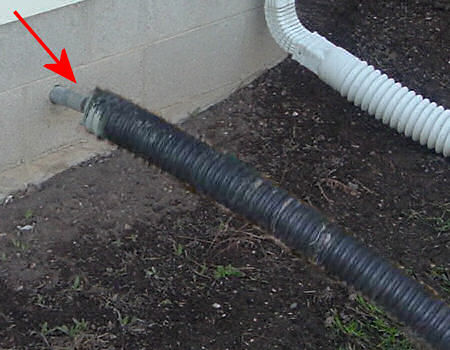 The larger hose may be an eye-sore but it's only for the winter months and it's usually covered with snow. For around $10, you can pick up 10 feet of this black drain hose. Disconnect the smaller hose from the pipe that exits your home. Then fasten the larger pipe with a piece of wire (a coat hanger works great) and a pipe clamp. This air gap is important to allow the hose to drain before it freezes. We all know if we stick a straw into a drink and hold the open end with our thumb the liquid will not drain out. The same is true for your sump pump drain pipe. The air gap shown by the arrow will allow any water to flow down the pipe and away from the foundation.
The larger hose may be an eye-sore but it's only for the winter months and it's usually covered with snow. For around $10, you can pick up 10 feet of this black drain hose. Disconnect the smaller hose from the pipe that exits your home. Then fasten the larger pipe with a piece of wire (a coat hanger works great) and a pipe clamp. This air gap is important to allow the hose to drain before it freezes. We all know if we stick a straw into a drink and hold the open end with our thumb the liquid will not drain out. The same is true for your sump pump drain pipe. The air gap shown by the arrow will allow any water to flow down the pipe and away from the foundation.
Also, the larger diameter hose is easier to keep clean if does get some ice in it. Make sure the hard pipe inside your home is slightly higher than the exit point to make sure the water fully drains each time your pump runs.
In spring, replace this hose with the one you normally use and everything should be just fine.


